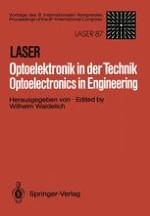1987 | OriginalPaper | Buchkapitel
Effects of High-Intensity TEA CO2 Laser Pulses on Austenitic Hadfield Steels
verfasst von : I. Sárady, B. Bengtsson, J. Meijer
Erschienen in: Laser/Optoelektronik in der Technik / Laser/Optoelectronics in Engineering
Verlag: Springer Berlin Heidelberg
Enthalten in: Professional Book Archive
Aktivieren Sie unsere intelligente Suche, um passende Fachinhalte oder Patente zu finden.
Wählen Sie Textabschnitte aus um mit Künstlicher Intelligenz passenden Patente zu finden. powered by
Markieren Sie Textabschnitte, um KI-gestützt weitere passende Inhalte zu finden. powered by
Metastable, austenitic Hadfield steels show extensive work hardening, due to martensitic transformation. Several articles describe the hardening, induced by plastic deformation, i.a. caused by explosion (1,2). The mechanisms of the transformation were also described (3,4). The idea of the present work was to investigate if highintensity laser pulses in vacuum can induce similar transformations. The rapid expansion of vaporized material produces a shock wave that propagates and gets absorbed in the material (5), causing work hardening/transformation. Shock-hardening effects have been demonstrated for a variety of materials, especially for A1 and its alloys by using Nd:YAG and Ruby lasers, combined with the “confined surface” technique (6,7,8,9). Possibilities of using TEA CO2 lasers to generate Laser Supported Detonation (LSD) waves for surface modification, have also been described (10,11). Some surface melting always occurs under such intense irradiation, depending on pulse length and intensity, etc. in a complicated way. Therefore, a theoretical, one-dimensional mathematical model was developed, based on the heat diffusion equation by using Finite Difference Method (EDM), to calculate the dependence of the energy transfer, the rate of vaporization, the thickness of the molten layer, the peak pressure, etc. as function of pulse shape and duration, wavelength of the radiation and the energy density (12).
